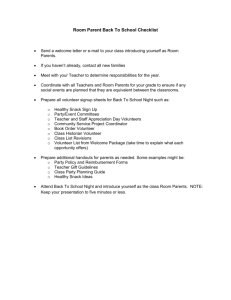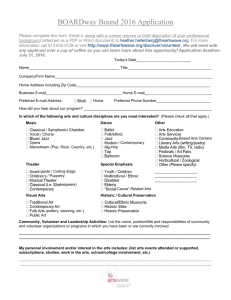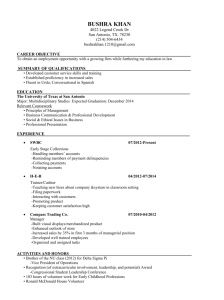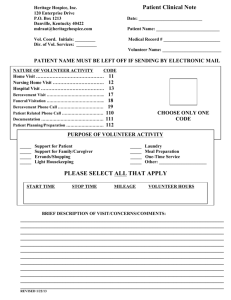Social Justice in K-12 Schools (SYLLABUS SAMPLE)
advertisement
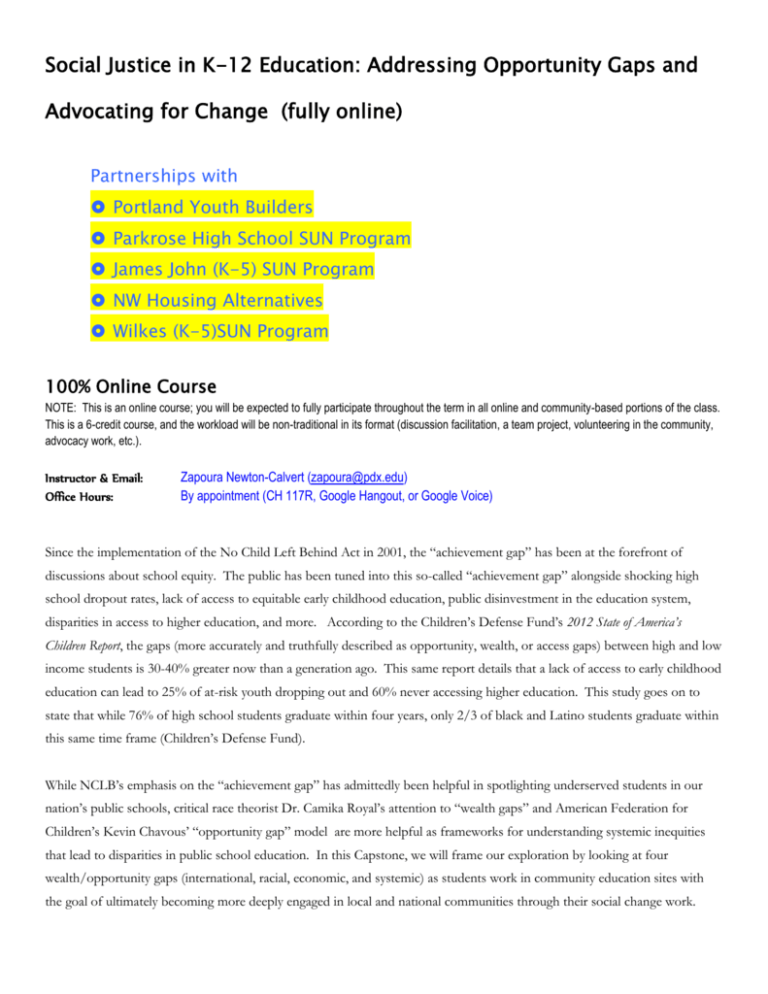
Social Justice in K-12 Education: Addressing Opportunity Gaps and Advocating for Change (fully online) Partnerships with Portland Youth Builders Parkrose High School SUN Program James John (K-5) SUN Program NW Housing Alternatives Wilkes (K-5)SUN Program 100% Online Course NOTE: This is an online course; you will be expected to fully participate throughout the term in all online and community-based portions of the class. This is a 6-credit course, and the workload will be non-traditional in its format (discussion facilitation, a team project, volunteering in the community, advocacy work, etc.). Instructor & Email: Office Hours: Zapoura Newton-Calvert (zapoura@pdx.edu) By appointment (CH 117R, Google Hangout, or Google Voice) Since the implementation of the No Child Left Behind Act in 2001, the “achievement gap” has been at the forefront of discussions about school equity. The public has been tuned into this so-called “achievement gap” alongside shocking high school dropout rates, lack of access to equitable early childhood education, public disinvestment in the education system, disparities in access to higher education, and more. According to the Children’s Defense Fund’s 2012 State of America’s Children Report, the gaps (more accurately and truthfully described as opportunity, wealth, or access gaps) between high and low income students is 30-40% greater now than a generation ago. This same report details that a lack of access to early childhood education can lead to 25% of at-risk youth dropping out and 60% never accessing higher education. This study goes on to state that while 76% of high school students graduate within four years, only 2/3 of black and Latino students graduate within this same time frame (Children’s Defense Fund). While NCLB’s emphasis on the “achievement gap” has admittedly been helpful in spotlighting underserved students in our nation’s public schools, critical race theorist Dr. Camika Royal’s attention to “wealth gaps” and American Federation for Children’s Kevin Chavous’ “opportunity gap” model are more helpful as frameworks for understanding systemic inequities that lead to disparities in public school education. In this Capstone, we will frame our exploration by looking at four wealth/opportunity gaps (international, racial, economic, and systemic) as students work in community education sites with the goal of ultimately becoming more deeply engaged in local and national communities through their social change work. The Social Justice in K-12 Education Capstone is a fully online model focused on (1) current local and national education issues, (2) educational equity in public education, and (3) hands-on and virtual tools for transformative social action. Capstone students will volunteer either in a hands-on or virtual placements working directly with youth or with an education advocacy organization (in the case of virtual placement). There will be three different tracks for participants: 1. Face-to-face volunteer work through pre-established Capstone partner sites local to Portland, Oregon These will include partnerships with Portland Youth Builders, NW Housing Alternatives, and James John SUN School. Placement will be facilitated by the instructor, who has a longstanding partnership with these organizations. 2. Face-to-face volunteer work through student-found partner sites local to the student (elsewhere in Oregon, the nation, or abroad). Students will be guided through various volunteer guides and search engines to find their own placement through a local education non-profit or school. Students will be given email and phone scripts in addition to information on other protocols for contact and modes of introduction/communication. Contracts will be signed and submitted, and a phone consult between the community partner and instructor is also required. 3. Virtual volunteer work through a student-chosen organization from a carefully selected and vetted list compiled by the instructor. This virtual volunteer work will be preliminary related to research, writing, and social media work to support schools and non-profits in outreach, fundraising (etc.) and may also include tutoring/mentoring for Oregon’s online charter school or other such public institutions. Students will be given email and phone scripts in addition to information on other protocols for contact and modes of introduction/communication. Contracts will be signed and submitted, and a phone consult between the community partner and instructor is also required. Note: Students must contact the instructor via email (Zapoura@pdx.edu) OR phone (971-270-4962) as soon as they register for the class for a conversation about the online format and about community site placement options. After initial contact, the instructor will send students a toolkit for community placement and for the technology used in the course! INSTRUCTOR’S ROLE My job, as your Capstone instructor, is to serve as a facilitator and advisor for your experience. Our work in the classroom should build a context for thinking more deeply as you provide service to the community. This is a community-based class not only in your service work but also in the classroom. The classroom community is built by all of us in an open, honest, and critical space. PSU VOLUNTEER ROLES: PSU students will spend 30 hours of volunteer work in the community, including tutoring, mentoring, classroom assistance and team project work. Hands-on Service (at least 2-3 hours a week at your placement site) The PIC Team Project Work (your hours will vary depending on the scope of your project) Additional Service Hours (handsonportland.org) (if you need additional hours, you can explore other volunteer placements engaging youth) (instructor approval needed) Your weekly hands-on and group work participation will be documented in your weekly journal. TEXTS/SUPPLIES: The Flat World and Education: How America’s Commitment to Equity Will Determine Our Future (Linda Darling-Hammond) The Life and Death of the Great American School System: How Testing and Choice Are Undermining Education (Diane Ravitch) Our D2L site will contain links to additional course readings AND we will crowd source some weekly readings as part of our online work together. Course Requirements/Evaluation: Your evaluation is based on all of the criteria for course requirements and policies. However, as indicated in the Student Capstone Guide, you are not evaluated only on the service aspects of the course in themselves, but on the learning demonstrated by your contributions to group work and the quality of group and individual written production and/or oral presentations. This Capstone is evaluated using a number of American Academy of Colleges and Universities VALUE Rubrics (all are included in our D2L course shell). Within each 8-point rubric, there are the following three categories: 1. 2. 3. Emerging (3-4 range) (B-/B) Proficient (5-6 range) (A-/A) Exemplary (7-8 range) (A+) In the first two weeks of the course, we will go through the evaluation rubrics and evaluation methods of the class thoroughly. You will take part in a variety of evaluation methods: self-evaluation, work sample submission, peer evaluation, evaluation from the community partner site, and instructor feedback. If you fall below the “Emerging” range on any piece of coursework, we will discuss the work and talk about ways to get into the Emerging-Proficient range. All students are expected to fall in the Emerging-Proficient range in the majority of their course work across all categories of our Capstone learning. IN CLASS/ONLINE LEARNING (Critical Reading, Thinking, and Sharing) (40% of final evaluation) Your final evaluation is a reflection of your work as a critical thinker, learner, speaker, and writer on topics surrounding public school education. Class Participation/Attendance: (15%) Participation: This is a hybrid course. You are required to participate both face-to-face in our class discussions AND online in our online discussion forums or on the PDX Education Action Network blog. Attendance: Attendance and class participation are expected and required. Notify in advance if you must miss a session or class period. o See details on attendance policy at the end of the syllabus. Online Discussions: As part of our hybrid class, we will all participate in weekly discussion forums (first in D2L and later on the PDXEAN blog). Your leadership (each student will initiate some weekly conversations) and participation is part of your overall class participation evaluation. You will be given a “complete” or “incomplete” grade for each week’s discussion work. Your final grade in “Participation” will be based on your Work Sample submissions at mid-term and Week 9. Short Conversation Starters & Facilitating Discussion (in class and online) (15%) Conversation Starters: You will be required to submit responses to the reading throughout the term and to bring a copy to class. Further instructions will be discussed in class. Discussion is a key component to our service learning this term. At mid-term and Week 9, you will submit a Work Sample of your best Reading Responses and a brief reflection for grading. Throughout the term, Conversation Starters will be graded as completed or incomplete (5 points or 0 points). Detailed instructions will be reviewed in class and available in the CONTENT section of our D2L course. Your final grade in Participation will be based on your Work Sample submissions. Discussion Facilitation: Discussion leading will be focused on linking course readings and topics to updated research and local experiences of students and educators in our community. Detailed instructions will be reviewed in class and available in the CONTENT section of our D2L course. SOCIALLY RESPONSIBLE LEARNING (60% of final grade) This portion of your grade will be evidenced in your interactions with one another and our community partner, your writing on your experience as a curriculum developer, teacher, and group project participant, your contributions to the group project, and the quality of the project itself. Hands-on Hours: Students must spend at least 30 volunteer and PIC Team Project hours. During the first week of class, we will be solidifying the volunteer schedule for the term. You will be able to choose the day/days and time/times you will volunteer each week. These should be consistent from week to week, as the students will begin to know you and expect you to be there. If you are ill or are not able to attend your volunteer slot, please directly contact the community partner to let them know in advance. It is critical that you do not miss or be late to your sessions. The community partners and the students will be depending on you; also, you will be representing PSU in the community, so responsible behavior is obviously essential. PIC teams will be created during the first two weeks of class. Weekly Reflective Journal & End-of-Term Snapshot (the documentation of hands-on and group project work): Each week’s journal entry submission should do the following: Record the specifics of your volunteer time and keep a log of hours you work. You will be asked to track your individual and group work with youth throughout the term. This should be descriptive, detailed, and personal, as well as connected to ideas we’re discussing in the course. Make connections between what you see in the classroom and what you see in the course readings/discussions. Be submitted by the Sunday following the volunteer week EACH WEEK. These will be checked each week. o If you do not volunteer during a particular week, please note that in your entry. Do not merely skip a week of journal entries. If you are sick, note that in your entry. o For the final class session, you will be asked to share a single story of a moment where you learned something during the community work. This can be gleaned from your journals. Participating in Community (PIC) Team Project: Independent Acts of Civic Engagement (15%) Volunteering on site with our various community partners is a primary focus of our learning this term. Beyond your learning as tutors/mentors/support volunteers with our community partners, we will also be talking about and developing skills around the bigger picture of civic engagement and how to get involved in the community. Group PIC projects will vary by group. Specific guidance and prompts for the group project will be given in Week 1 or 2 of the course. Culminating Reflection & Snapshot (10%) The culminating reflection for the course will give you three options for connecting the pieces of your learning and making plans for future thinking and/or action in your community. This will be submitted in lieu of a final journal entry and will be slightly more substantial in length and thinking. Specific instructions appear in the CONTENT of our D2L course. As part of this final reflection process, you will share some of your learning/reflections (the Snapshot) on our last day of class Week 8. Policies: Attendance: Attendance and class participation are expected and required. It is critical that you do not miss or be late to your sessions. The community partners and the students will be depending on you; also, you will be representing PSU in the community, so responsible behavior is obviously essential. Notify in advance if you must miss a session or class period. More than 1 PSU absences will lower your grade by one grade (i.e., B becomes B-). Two or more absences may result in failure or mandatory withdrawal. It is important to be to class on time as your being late will keep the group from functioning as a whole. Therefore, 2 late arrivals = 1 absence. Late Work: Late work is not accepted unless previous arrangements have been made. Paper Format: Typed, double-spaced, proofread, thoughtful Course Goals As members of the Enhancing Youth Literacy learning community, students will become familiar with key issues in local education, national education, and education policy. identify processes, core concepts, and modes of action and engagement relevant to the key issues in education discussed in class empower themselves and each other to apply knowledge in those key issues as informed action in the community apply these civic engagement skills within hands-on community partner placement experiences and beyond (either within education or other key social justice issues impacting our community) use technology to mobilize, connect, and share information about educational equity Through the course goals and outcomes, students will engage deeply with learning in the four key university studies areas: inquiry and critical thinking, communication, diversity of human experience, and ethics and social responsibility. Course Outcomes Evaluate, analyze, and compare primary and secondary sources detailing key issues of education and educational equity in order to challenge assumptions about schools and learning in the U.S. Pieces of the AACU Critical Thinking rubric will be used for evaluation. (UNST Inquiry and Critical Thinking Goal) Make connections between course materials and experience at the volunteer placement site and provide evidence through discussion and reflective writing of a willingness to challenge personal and systemic assumptions about our course's key education issues. (UNST Inquiry and Critical Thinking and Diversity of Human Experience Goals) Learn and use diverse forms of communication (blogging, email, oral presentations, and letter writing) to nurture relationships within small groups, with the community partner, and with the larger public. In-class workshops on these forms will be included. (UNST Communication Goal) Use multiple models/scales of intercultural sensitivity (including the Bennett scale) and understanding of the culture of power (from Lisa Delpit's "The Silenced Dialogue") to read, interpret, and discuss/write reflectively and to use these scales to analyze bias and privilege. (UNST Diversity of Human Experience and Ethics and Social Responsibility Goals) Analyze written and hands-on best practices in community volunteering, outreach, and school reform and to develop modes or plans for future civic engagement on a small or big picture level (voting, continued activism, parenting practices, support for extended family, etc.) (UNST Inquiry and Critical Thinking and Ethics and Social Responsibility Goals) To apply in-class and on-site learning to empower youth, the self, or others to initiate new content, create new partnership possibilities and/or take ownership of specific aspects of the of the small group work, role at the community partner site, and/or classroom discussion (online or face to face). Evidence of this work will take place in reflective journals and the culminating assignment. (UNST Communication and Ethics and Social Responsibility Goals) The overarching course rubric appears here: http://www.aacu.org/value/rubrics/pdf/CivicEngagement.pdf.

